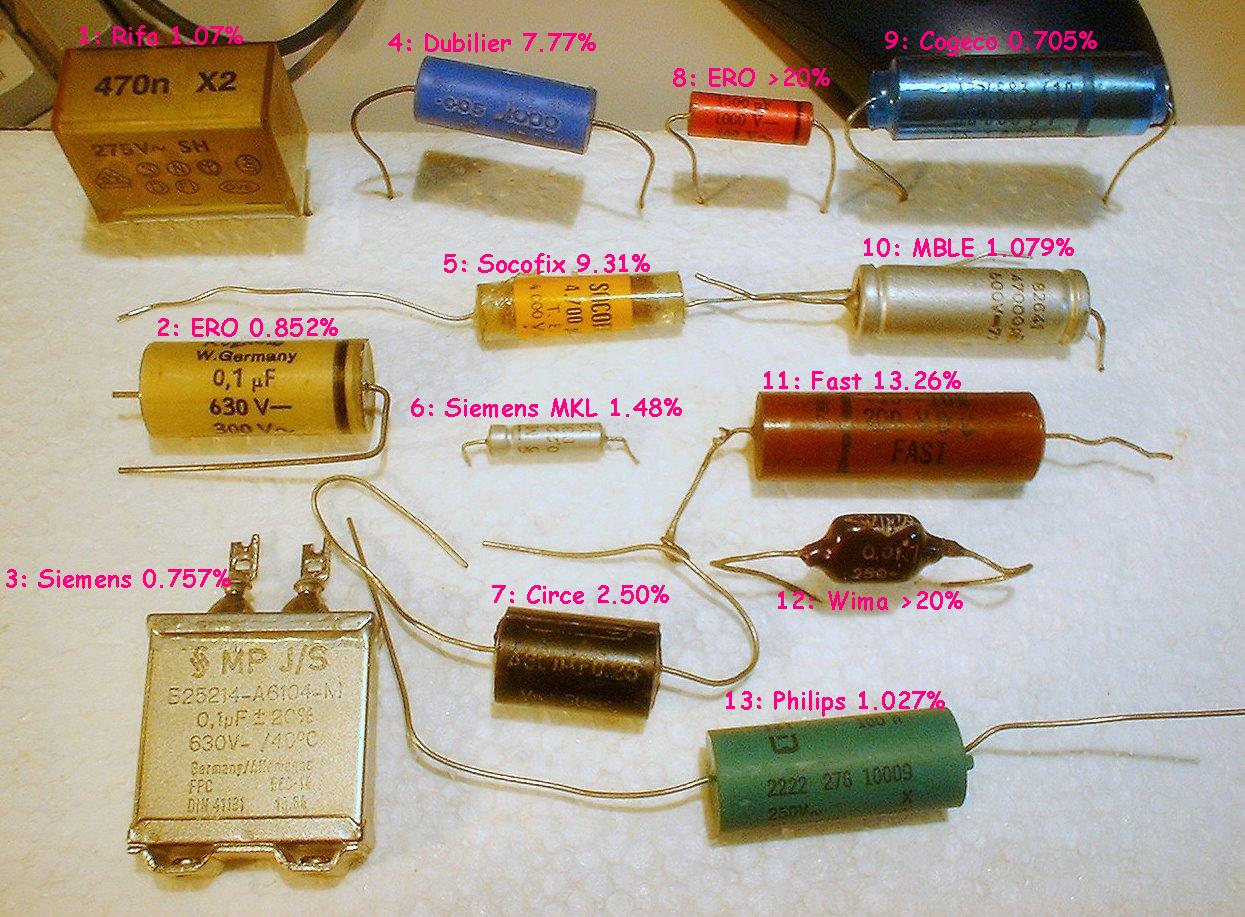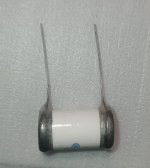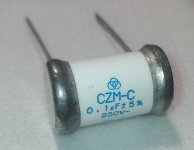@MarcelvdG, yes, the capacitors that I used had an other color with a green stripe if I remember correctly, I threw them away.
The ceramic capacitors left in the circuit are those at the input stage to limit the upper frequency and to prevent oscillation. They are recent ones, brown coloured, 330pF. They do not seem to hurt the sound. However next time I will skip using ceramic capacitors at all.
The ceramic capacitors left in the circuit are those at the input stage to limit the upper frequency and to prevent oscillation. They are recent ones, brown coloured, 330pF. They do not seem to hurt the sound. However next time I will skip using ceramic capacitors at all.
Humm, most people say that they are looking at pictures and writing here. Although they are very enthusiastic, they are not accurate in judging the details of the appearance. In fact, this is a ceramic shell-encapsulated oil-paper dielectric capacitor, not a dielectric porcelain tube.
The dielectric porcelain tube should have at least a silver-plated layer used for electrode at the outer end and a uniform insulating paint coating. The porcelain tube here is just an ordinary talc porcelain/electric isolated porcelain shell. Its surface has enamel with low porosity (common characters are also burned together with enamel) to achieve strict air tightness. After nickel/silver metallization is used at both ends of the ceramic shell, the cap-shaped lead-out electrodes at both ends are completely welded and sealed with solder, so that the air-tight structure will be difficult for moisture to enter, and the reliability is better.
It is a usually one type of airtight structure in paper media that can last for a long time. Most products still have good usability after thirty or forty years or even longer.
In China, it is generally used in high reliable production lines such as military industry, and the cost is relatively expensive.
This model is called CZM-C in China, and it comes from Cap+ paper(纸,Zhi)+ sealing (密封,Mi-feng)+ porcelain shell (瓷,Ci). Produced by the former military factory, it has been discontinued for many years.
The dielectric porcelain tube should have at least a silver-plated layer used for electrode at the outer end and a uniform insulating paint coating. The porcelain tube here is just an ordinary talc porcelain/electric isolated porcelain shell. Its surface has enamel with low porosity (common characters are also burned together with enamel) to achieve strict air tightness. After nickel/silver metallization is used at both ends of the ceramic shell, the cap-shaped lead-out electrodes at both ends are completely welded and sealed with solder, so that the air-tight structure will be difficult for moisture to enter, and the reliability is better.
It is a usually one type of airtight structure in paper media that can last for a long time. Most products still have good usability after thirty or forty years or even longer.
In China, it is generally used in high reliable production lines such as military industry, and the cost is relatively expensive.
This model is called CZM-C in China, and it comes from Cap+ paper(纸,Zhi)+ sealing (密封,Mi-feng)+ porcelain shell (瓷,Ci). Produced by the former military factory, it has been discontinued for many years.
Attachments
The loss-factor degrades together with capacitance. If that poor old cap is still within its possible rated tolerance (I guess it can be +-10..15%), it may still be fine today. So, a capacitance measurement can show us if it is really hermetic or not.Paper is a hopeless dielectric in practice, over time it absorbs moisture, changing the capacitance value and increasing the loss-factor and leakiness, and also oxidation can occur degrading the dielectric with similar issues. That's why its not used any more.
Some measured data (the losses are heavily correlated to the linearity):
I have also measured a ceramic encased paper cap, but due to the lousy search engine of the forum, I am unable to locate it un fortunately
Yeah, Wima is one of the best: see N°12:

The paper in that capacitor is not the sheet from your exercise book. It is a very special material developed for insulation in transformers where dielectric properties are of high importance. Also the metal foil is usually tin foil in contrast to the aluminium vacuum deposit found in metallized plastic capacitors. I would not discard them. Measure ESR or D at 1 kHz, 10 kHz (and 100 kHz if you can).
If its pure nomex, its not actually paper! Nomex is just another type of polyester (like mylar, kevlar and others).The paper in that capacitor is not the sheet from your exercise book. It is a very special material developed for insulation in transformers
Humm, what you said is correct. This kind of paper belongs to the classification of capacitor paper, which is characterized by low halogen content, high insulation resistance, high purity fiber, thin and tensile, and good flatness. It is more different from ordinary paper than ashless filter paper and qualitative filter paper.The paper in that capacitor is not the sheet from your exercise book.
In the later process, aluminum foil is used instead of tin foil. At least the CZM-C in my hand is the type of aluminum foil. Moreover, I have never seen this kind of antique process, like modern polypropylene, which is bonded by an alloy powder at both ends, but more like the purest winding process. Their ESR value is not necessarily better, although they claim to be foil electrode.Also the metal foil is usually tin foil in contrast to the aluminium vacuum deposit found in metallized plastic capacitors. I would not discard them. Measure ESR or D at 1 kHz, 10 kHz (and 100 kHz if you can).
Moreover, due to the natural performance problems of paper, even the pure cellulose D value can't be very low. Paper capacitors should not show how excellent their parameters are by performance to prove their excellent listening. The ultimate pursuit of audio does not mean the ultimate pursuit of high fidelity, and everyone has his own interests and can't force it.
In addition, metallized paper capacitors (CJ series, including air-tight and non-air-tight) were produced in the later period of China. Because of the poor performance of capacitor paper, the reliability of general civilian technology and low-end military technology of this kind of capacitors is really a mess.
Paper capacitors should not show how excellent their parameters are by performance to prove their excellent listening. The ultimate pursuit of audio does not mean the ultimate pursuit of high fidelity, and everyone has his own interests and can't force it.
Just like vacuum tubes: they are noisy and distorting, still many prefer them. Listening not always correlates with parameters.
Just like vacuum tubes: they are noisy and distorting, still many prefer them. Listening not always correlates with parameters.
- Home
- Design & Build
- Parts
- Paper capacitors?

